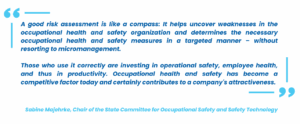Home > The news of EUROGIP and occupational risks in Europe >
As part of Germany’s joint occupational health and safety strategy (GDA), a survey was carried out to assess the development of occupational health and safety in companies. Between September 2023 and April 2024, 3,817 companies and 3,824 employees were interviewed by telephone by the Institute for Applied Social Sciences (INFAS). According to the results, occupational health and safety has made major progress over the last ten years.
Significant increase in company risk assessments
The survey reveals that 68% of companies declare that they carry out risk assessments, 16% more than in 2015. While those with 50 or more employees remain at a high level, there has been a very marked increase in the number of micro-businesses declaring that they carry out this assessment, now standing at 61% (compared with just 42% in 2015). What’s more, its usefulness was judged “high” in almost two-thirds of cases. In cases where it was deemed “low”, the majority of respondents felt that there were simply no significant hazards in the company (63%).

Several other noteworthy developments
Compared with 2015 data, improvements were seen in a range of other indicators:
- more managers have received OHS-related training (up from 39% in 2015 to 64% in 2024);
- employees are more often involved in risk assessments (79% vs. 68% previously);
- 77% of companies find the rules easy to understand and 75% find them easy to implement;
- 67% of companies rated their knowledge of OHS regulations as “fairly high” or “very high”.
In addition, the GDA had defined four themes as priorities: company controls, chemical products, psychosocial risks and musculoskeletal disorders. The results of the survey show that musculoskeletal and psychological constraints are much more often taken into account in risk assessments than in the past. Overall, there is a positive trend in the development of OHS in companies.
A call to step up efforts
Although the results are perceived as positive, the survey points out that certain objectives have yet to be achieved. In fact, almost a third of companies have not carried out a risk assessment 30 years after this legal obligation came into force.
The situation is similar when it comes to regulatory obligations relating to occupational medicine and safety organization within companies. In Germany, there are two distinct systems: the “standard model” (Regelmodell) and the “entrepreneurial model” (Unternehmermodell).
In the standard model, the occupational physician and safety professionals visit the company at regular intervals. They are responsible for occupational health and safety. However, according to their own statements, 44% of companies following this model have not appointed a safety officer, and almost 60% do not have an occupational physician.
For companies with fewer than 50 employees, the entrepreneurial model allows the employer to undergo occupational health and safety training in order to assume this responsibility himself. Once this training has been validated, the occupational physician only intervenes when specifically required. However, 34% of company managers following this model do not carry out the required training. Finally, only 58% of companies with over 20 employees have a workplace safety committee, as required by law.









